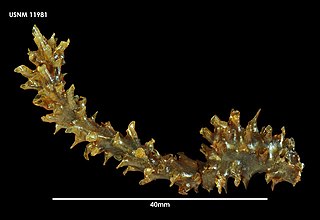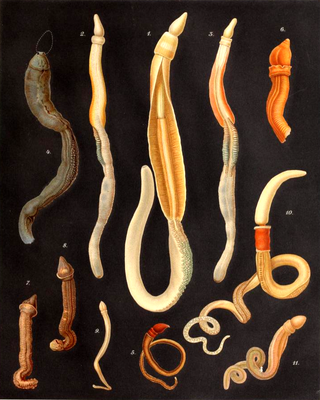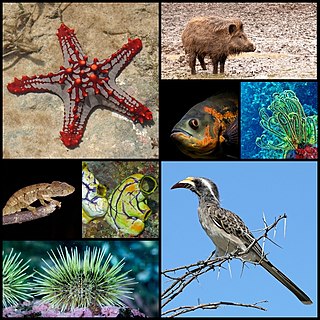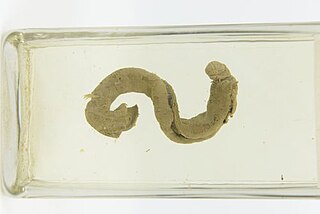
Hemichordata is a phylum which consists of triploblastic, enterocoelomate, and bilaterally symmetrical marine deuterostome animals, generally considered the sister group of the echinoderms. They appear in the Lower or Middle Cambrian and include two main classes: Enteropneusta, and Pterobranchia. A third class, Planctosphaeroidea, is known only from the larva of a single species, Planctosphaera pelagica. The class Graptolithina, formerly considered extinct, is now placed within the pterobranchs, represented by a single living genus Rhabdopleura.

Nemertea is a phylum of animals also known as ribbon worms or proboscis worms, consisting of 1300 known species. Most ribbon worms are very slim, usually only a few millimeters wide, although a few have relatively short but wide bodies. Many have patterns of yellow, orange, red and green coloration. The foregut, stomach and intestine run a little below the midline of the body, the anus is at the tip of the tail, and the mouth is under the front. A little above the gut is the rhynchocoel, a cavity which mostly runs above the midline and ends a little short of the rear of the body. All species have a proboscis which lies in the rhynchocoel when inactive but everts to emerge just above the mouth to capture the animal's prey with venom. A highly extensible muscle in the back of the rhynchocoel pulls the proboscis in when an attack ends. A few species with stubby bodies filter feed and have suckers at the front and back ends, with which they attach to a host.

Graptolites are a group of colonial animals, members of the subclass Graptolithina within the class Pterobranchia. These filter-feeding organisms are known chiefly from fossils found from the Middle Cambrian through the Lower Carboniferous (Mississippian). A possible early graptolite, Chaunograptus, is known from the Middle Cambrian. Recent analyses have favored the idea that the living pterobranch Rhabdopleura represents an extant graptolite which diverged from the rest of the group in the Cambrian.

Pterobranchia, members of which are often called pterobranchs, is a class of small worm-shaped animals. They belong to the Hemichordata, and live in secreted tubes on the ocean floor. Pterobranchia feed by filtering plankton out of the water with the help of cilia attached to tentacles. There are about 25 known living pterobranch species in three genera, which are Rhabdopleura, Cephalodiscus, and Atubaria. On the other hand, there are several hundred extinct genera, some of which date from the Cambrian Period.

The acorn worms or Enteropneusta are a hemichordate class of invertebrates consisting of one order of the same name. The closest non-hemichordate relatives of the Enteropneusta are the echinoderms. There are 111 known species of acorn worm in the world, the main species for research being Saccoglossus kowalevskii. Two families—Harrimaniidae and Ptychoderidae—separated at least 370 million years ago.

Ambulacraria, or Coelomopora, is a clade of invertebrate phyla that includes echinoderms and hemichordates; a member of this group is called an ambulacrarian. Phylogenetic analysis suggests the echinoderms and hemichordates separated around 533 million years ago. The Ambulacraria are part of the deuterostomes, a clade that also includes the many Chordata, and the few extinct species belonging to the Vetulicolia.

Scotoplanes is a genus of deep-sea sea cucumbers of the family Elpidiidae. Its species are commonly known as sea pigs.

Deuterostomes are bilaterian animals of the superphylum Deuterostomia, typically characterized by their anus forming before the mouth during embryonic development. Deuterostomia is further divided into 4 phyla: Chordata, Echinodermata, Hemichordata, and the extinct Vetulicolia known from Cambrian fossils. The extinct clade Cambroernida is also thought to be a member of Deuterostomia.

Saccoglossus is a genus of acorn worm. It is the largest genus in this class, with 18 species.
Swima is a genus of marine polychaete worms found in the ocean at depths between 1,800 and 3,700 meters. Even if they are agile swimmers, they are often seen hanging immobile in the water column as they are neutrally buoyant. This deep ocean pelagic (free-swimming) genus has modified bioluminescent gills that can be cast off from an individual. These discarded gills somewhat resemble green "bombs" that remain illuminated for several seconds after they have been discarded. It is thought that this is a defensive mechanism rather than reproductive, as it is seen in both mature and juvenile individuals. And because they are eyeless, communicating with light would be difficult. Swima worms are closely related to the recently discovered genus Teuthidodrilus, another pelagic cirratuliform of the bathyal zone.

Harrimaniidae is a basal family of acorn worms. A taxonomic revision was undertaken in 2010, and a number of new genera and species found in the Eastern Pacific were described. In this family the development is direct without tornaria larva, and circular muscle fibers in their trunk is missing. There is some indication that Stereobalanus may be a separate basal acorn worm lineage, sister to all remaining acorn worms.

Rhabdopleura normani is a small, marine species of worm-shaped animal known as a pterobranch. It is a sessile suspension feeder, lives in clear water, and secretes tubes on the ocean floor.
Yoda purpurata is a species of acorn worm discovered 2.5 km below the surface of the Atlantic ocean, and was the first of the genus Yoda found. Ranging from 12 to 19 cm in length, it was named after the fictional character Yoda from the Star Wars franchise. It was the first known hermaphroditic member within the phylum. The other known hermaphroditic member of the phylum is Yoda demiankoopi discovered in 2021.
Saccoglossus bromophenolosus is a species of acorn worm occurring in the northwestern Atlantic Ocean and the northeastern Pacific Ocean. It grows to a length of about 20 cm (8 in) and lives in a burrow in soft sediment in the intertidal and subtidal zones. The scientific name refers to 2,4-dibromophenol, a secondary metabolite present in this worm.

Karen Joyce Osborn is a marine scientist at the Smithsonian's National Museum of Natural History Invertebrate Zoology department. She is known for her work in marine biology specializing in mid-water invertebrates.
Cornelius Jan van der Horst was a Dutch biologist who worked mainly on marine biology and embryology in both the Netherlands and South Africa. As an undergraduate he studied botany and zoology at the University of Amsterdam where he was appointed assistant in the Botany Department under Professor Dr Hugo de Vries before moving on to assist Max Wilhelm Carl Weber at the University's Zoological Museum and in 1917 he became the principal assistant for general Zoology. In 1916 he published his thesis De motorische kernen en banen in de hersenen der visschen. Hare taxonomische waarde en neurobiotactische beteekenis. The research for this thesis was carried out at the Netherlands Central Institute for Brain Research under C. U. Ariëns Kappers. In 1925 Van der Horst was appointed Deputy Director of this Netherlands Central Institute for Brain Research and in 1928 he moved to South Africa where he took up a post as senior lecturer in zoology at the University of the Witwatersrand in Johannesburg. in 1932 he was promoted to professor in zoology at this University.

Imants (Monty) George Priede is a British-Latvian zoologist, author and academic. He is Professor Emeritus in the University of Aberdeen, Scotland known for his work on fish and life in the deep sea.
Coleodesmium is a monotypic genus of worms belonging to the family Torquaratoridae. The only species is Coleodesmium karaensis.

Balanoglossus gigas is a species of large free-living enteropneust found in the Atlantic Ocean. It is the largest acorn worm currently known, and has a strong iodoform-like odour. It is bioluminescent.














